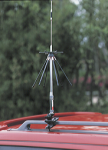I think there is a misconception on this particular discone antenna. It is not a large base antenna.
No misconceptions, many of us have seen them in the hamster fest parking lots.
As for an antenna….
UHF plugs don't make good antenna mounts. The shielded banana plug connector was never designed for mobile antenna mounting.
They also tend to sort of suck loudly above 300MHz.
The 'discone' part of the antenna is only going to be good at higher frequencies, where UHF connectors do the loud sucking noises. Essentially it's an elevated feed antenna with a really small discone at the base. The discone elements probably act as a bit of a ground plane on higher frequencies.
Do they work? I'm sure they do, no reason why they shouldn't. Heck, I can make a paper clip into a halfway decent antenna.
Are they going to work well? I'm sure it works well on the ham bands. I don't think it's a magical antenna that's going to out perform anything else. It's marketing gimmick is that it takes two different antenna designs and combines them. Most hobbyists know discones, so are attracted to them. Until I see a side by side comparison done on the same vehicle in the same location, I'm not believing any of the hype. I'll point out that the 'scantenna' was thought to be a bit of a joke until
@prcguy did some real world testing with it and found it actually worked fairly well. So, we can always be proven wrong.
Speaking of attracted to them, they usually get snickers at the ham fests. They are considered a "Hey! Look at me!" antenna. Some people like that, some don't. Count me in the "don't" category. Your opinions are likely different than mine. Not my car, not my antenna, you do what you want. Don't pay attention to the random stranger on the internets.
If that's what you want, then it's the perfect antenna. If you want something that's going to work well, there are other and better options. The small size of the discone may work well up in the 800MHz band, but remember, discone antennas have 0dB gain, so a dedicated 800MHz antenna can be had with 3-5dB gain, and it'll be smaller and work better, not to mention look less dorky (my opinion).
For dual band ham use, you can get the same effect, and probably better at that, by doing a permanent mount NMO (over a proper ground plane) dual band antenna like the Larsen NMO-2/70. The ground plane provided by the discone elements are not big enough to act as a ground plane on VHF.




